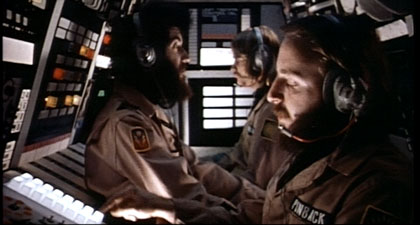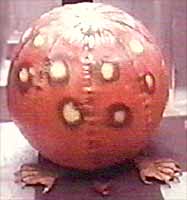|
Carpenter had first seen this film as a Waiting for Godot in outer space. He and O'Bannon finished a fifty-minute film at the University of Southern California (USC). However, the USC Cinema department did not want to allow them to show it at film festivals because it was 30 minutes too long.
So their only option was to shoot more footage to make it feature-length.
The plot: Four astronauts in deep space, whose mission is to destroy unstable planets in star systems which are to be colonised, have gradully over 20 years grown as unstable as the planets they seek to destroy. Unfortunately, so have the Smart Bombs they use.
 |
Cast
Brian Narelle - Lt. Doolittle
Cal Kuniholm - Boiler
Dre Pahich - Talby
Dan O'Bannon - Sgt. Pinback
(Dre's dialog was dubbed by John Carpenter).
|
According to O'Bannon: "Expanding it meant we were going to have to shoot a lot of scenes that were filler, and that would lessen the tightness of the story and make it into an episodic form. It was kind of disappointing, because that meant we had to go from the most impressive student film ever made to to one of the cheapest features in history."
Making the film at USC enabled Carpenter and O'Bannon to use a "relatively leisured" pace.
"We would shoot for a few days, then we would stop for a couple of weeks while we scraped together enough resources and money to shoot another scene or two."
Because they didn't have a lot of money, Carpenter and O'Bannon decided to make that shortage of funds work into the plot.
"2001 was big and spectacular and shiny and clean, we decided to go the opposite way and make Dark Star small and grubby and funny. This was the seventies...We figured we'd put a bunch of hippies out in space and make everything look rundown."
This came to be known as the "used future" look, as represented in movies as diverse as Alien and Star Wars.
O'Bannon wasn't satisfied with that rundown look in Dark Star, but felt that Ridley Scott got it right with Alien (for which O'Bannon had written the script). "He knew that if you wanted the audience to actually see that the details of the set were kind of grubby, you had to build it five times exaggerated, or the camera wouldn't even pick it up. When they started dressing the control room set, I walked around and saw all the broken things hanging down and I started getting concerned. It looked like a bad joke. But then when I saw some dailies, I thought, oh, it looks just right. Ridley knew how to get that on screen."
Some of the humor may be lost on a modern day audience. For example the video diary of Sergeant Pinback is actually an 8-track tape, and the machine he uses to record it is a microfiche machine. Who under the age of 30 knows what they were?
The planets shown in the film were actually beach balls. Due to a bit of serendipity, a beah ball would soon be featured in a more memorable role.
| "What we would do with this giant beach ball is use bathroom plungers to hold it up, pain it, and photograph the top of its surface. Someone who was helping on the film was carrying this inflated beach ball, and O'Bannon and I immediately looked at each other and said, "What if the alien who is supposed to be on board looked like a beach ball with legs?"
We spray painted the beach ball, put monster claws beneath it, and got Nick Castle behind it to be the claws and give them some sort of life. |
 |
The falling elevator
In one of the added scenes, Dan O'Bannon as Sgt Pinback dangles near the top of a long elevator shaft, as the elevator falls. How to film it?
The elevator shaft was built on a sound stage, about eighty feet long. It was horizontal. They turned the camera on its side and shot both sideways and upside down.
"When you see him dangling from the elevator, he's merely lying on a platform sticking his feet up to appear like he's in danger of falling. The elevator itself was a crab dolly with a piece of masonite in front of it, painted silver. You only seeing the bottom of it."
O'Bannon needed an appendectomy after filming that scene, and has always thought that doing his own stunts was the cause, as he had to lie on his side and continuously hold his legs up at an angle to simulate falling, putting stress on his appendix.
Bibliography
Fast, Cheap and Under Control, John Gaspard, Michael Weise Productions, 2006
Return to:
 |
Click on the icons for new features in The Thunder Child.
Radiation Theater: 1950s Sci Fi Movies Discussion Boards
The Sand Rock Sentinel: Ripped From the Headlines of 1950s Sci Fi Films
|
 |
|







